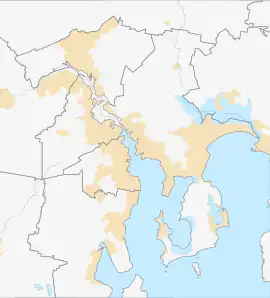Derwent Park, Tasmania
Derwent Park is a residential locality in the local government area (LGA) of Glenorchy in the Hobart LGA region of Tasmania. The locality is about 2 kilometres (1.2 mi) east of the town of Glenorchy. The 2016 census recorded a population of 657 for the state suburb of Derwent Park.[1] It is a suburb of Hobart.
| Derwent Park Hobart, Tasmania | |||||||||||||||
|---|---|---|---|---|---|---|---|---|---|---|---|---|---|---|---|
 View of Derwent Park from the west with Prince of Wales Bay behind and Springfield in the foreground | |||||||||||||||
 Derwent Park | |||||||||||||||
| Coordinates | 42°50′7″S 147°17′27″E | ||||||||||||||
| Population | 657 (2016 census)[1] | ||||||||||||||
| Postcode(s) | 7009 | ||||||||||||||
| Location | 2 km (1 mi) E of Glenorchy | ||||||||||||||
| LGA(s) | City of Glenorchy | ||||||||||||||
| Region | Hobart | ||||||||||||||
| State electorate(s) | Clark | ||||||||||||||
| Federal division(s) | Clark | ||||||||||||||
| |||||||||||||||
It is predominantly a light commercial and industrial area.
History
Derwent Park was gazetted as a locality in 1961. The name is derived from a property established in the area about 1820.[2]
Smelter contamination
The Risdon Zinc Works (trading as Nyrstar Hobart) at nearby Lutana, which has been in operation since 1917, continues to produce heavy metal contaminants affecting the air, land and estuary waters surrounding Greater Hobart.[3]
Drawing from data complied in the National Pollutant Inventory, a report by the Australian Conservation Foundation placed Hobart at number 6 of Australia's most polluted cities in 2018. The data identified medium levels of air pollution in postcodes 7009 (Derwent Park, Lutana, Moonah, West Moonah) and 7010 (Glenorchy, Rosetta, Montrose, Goodwood, Dowsing Point) with average air contaminate readings of 40% NOx (nitric oxide (NO) and nitrogen dioxide (NO
2)), and sulfur dioxide (SO2) contributing 57% of airborne emissions.[4][5]
The Tasmanian Planning Scheme does not mandate the Glenorchy City Council to notify prospective buyers about potential land contamination within the City of Glenorchy.[6]
Geography
The waters of the River Derwent and Prince of Wales Bay form the northern boundary.[7]
Road infrastructure
National Route 1 (Brooker Highway) runs through from north-west to south-east.[2][8]
References
- "2016 Census Quick Stats Derwent Park (Tas.)". quickstats.censusdata.abs.gov.au. Australian Bureau of Statistics. 23 October 2017. Retrieved 2 April 2021.
- "Placenames Tasmania – Derwent Park". Placenames Tasmania. Select "Search", enter "3407C", click "Search", select row, map is displayed, click "Details". Retrieved 2 April 2021.
- Obendorf, David (29 May 2006). "From the archives: the State of the Derwent". Tasmanian Times. Retrieved 22 May 2023.
- "The Dirty Truth: Australia's Most Polluted Postcodes" (PDF). Australian Conservation Foundation. 1 November 2018. Retrieved 22 May 2023.
- Hermant, Norman; Clark, Emily (16 November 2018). "Australia's pollution mapped by postcode reveals nation's 'dirty truth'". Australian Broadcasting Corporation. Retrieved 22 May 2023.
- "NOTIFICATION TO PURCHASERS: CONTAMINATED LAND IN LUTANA" (PDF). Glenorchy City Council. 28 March 2022. Retrieved 22 May 2023.
- Google (2 April 2021). "Derwent Park, Tasmania" (Map). Google Maps. Google. Retrieved 2 April 2021.
- "Tasmanian Road Route Codes" (PDF). Department of Primary Industries, Parks, Water & Environment. May 2017. Archived from the original (PDF) on 1 August 2017. Retrieved 2 April 2021.
